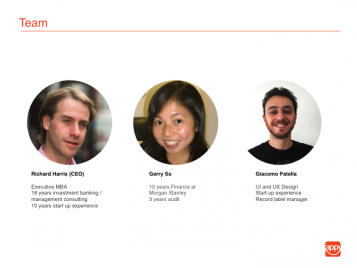Our CEO, Richard Harris presented at the Bloomberg NOTWICS (Now That’s What I Call Startups) event on the 25th November in front of a packed room of investors.
This was a chance for a number of start-up companies to pitch to investors and network afterwards. There were about 80 people in the room and about 10 companies pitching, ranging from an app to create and share content about events or holidays – Kombie to Raceful.ly who helps you stay motivated and keep fit with friends from around the world. There was even another company in the job management space – Workgaps although they are focused more towards recruitment and managing of temporary staff.
The event was good, we got some good feedback from our pitch and thought it would be worth sharing some of the slides and text.
Introduction and Outline to Okappy


Okappy is a B2B Market Network combining the benefits of a marketplace like Uber, a social network such as LinkedIn and Cloud based Software as a Service. Using our network, companies can
- connect to their customers and subcontractors,
- send and receive jobs, and
- share the status of those jobs, as they’re updated by their employees, wherever they are.
What Problem is Okappy is Solving

3 years ago, Graham Warby from EP Response approached me with a problem. His customers wanted him to expand, but he was finding it difficult to manage his employees and subcontractors. He was using paper job sheets to allocate work. This was leading to
- lots of admin,
- no one knows what’s happening until the job sheet is returned, and
- missing job sheets resulted in late, forgotten or missed invoices.
On a £300 average job, Graham believed paper job sheets were costing him about £40 in total. Not to mention the lost revenue he was foregoing by not expanding. We were tracking his vehicles as part of a previous startup – AutoAlert. He asked if we could also track his jobs. We started developing the job management software but quickly realised that there was a much bigger opportunity. His customers wanted to connect and send jobs rather than relying on emails and faxes. Graham also wanted to send jobs to his own subcontractors. Therefore, we started developing the market network and in July 2015, Okappy was born.
Market and Competition

Communication is a problem for many companies, just think how many companies have employees or subcontractors at different locations. There are 14 million field service companies in Europe and North America alone. However, given our size, we’re focusing on Electrical contractors initially.
We know the market. We have customers already and we have seen that they have an acute problem. They often use subcontractors and often dependant on paper job sheets. There are 40,000 electrical contractors in the UK, of which 5,000 have a turnover between £500k and £20m. We find that this size of company is our sweet spot. They’re big enough that they have the time and inclination to look at new ways of working, they are often ambitious but not too big that they already have other systems in place.
Competition
Companies can obviously maintain the status quo and continue to use paper job sheets. We are also seeing more companies trying to mix lots of different solutions together, applications such as Google Calendar, Slack along with Email. This can work for smaller companies but can quickly become unmanageable as your work load increases. Rather than being snowed under with paperwork, companies just end up fighting a deluge of emails. Larger companies have access to Enterprise Resource Planning (ERP) systems from the likes of Oracle, SAP and IBM. However, they are complex, expensive and out of reach for the majority of companies in this industry,
Consequently a number of new start-ups have been established recently including Geoop and vWorkApp from New Zealand Australia and Locqus in the United States. They offer a more simple job management solution based around smartphones. All these solutions can work well internally but where they all fall down is when other stakeholders are involved in the job.
Companies don’t work in isolation. In this global economy you often have many customers and subcontractors involved in each job. As soon as you want to involve these stakeholders then this leads to duplication, copying information from one application to another and generally more work. This is where Okappy really stands out with our market networked approach.
Team

Gerry and I set up Okappy in July 2015. Previous to Okappy, Gerry worked for 11 years at Morgan Stanley in Finance. I also have a background in Investment Banking and Management Consulting before doing an Executive MBA and then founding another startup. We have been joined recently by Giacomo Patella who brings design expertise especially around user experience to the team. The next stage in our growth is to concentrate on the viral nature of our product and improve our customer on-boarding and this is where we feel Giacomo can add value.
Traction, Raise and Exit
In the interests of financial promotion, we’ve taken out these slide for public consumption. However if you are interested in finding out more, don’t hesitate to get in touch.
In summary though, we have customers using the software, they’re processing thousands of jobs through the system. What is really exciting, is the amount of invites they’ve sent to their customers and subcontractors and the number of job sheets and invoices they’ve raised through the platform. Every time one of our customers sends an invite, job sheet or invoice, this is an opportunity for us to bring more customers on to the platform.
Further Information
The presentation went well and we got a lot of interest in the networking afterwards. We’re keen to hear your thoughts and if you are interested in finding out more or would like a copy of these slides or our investment deck then please don’t hesitate to get in touch.




